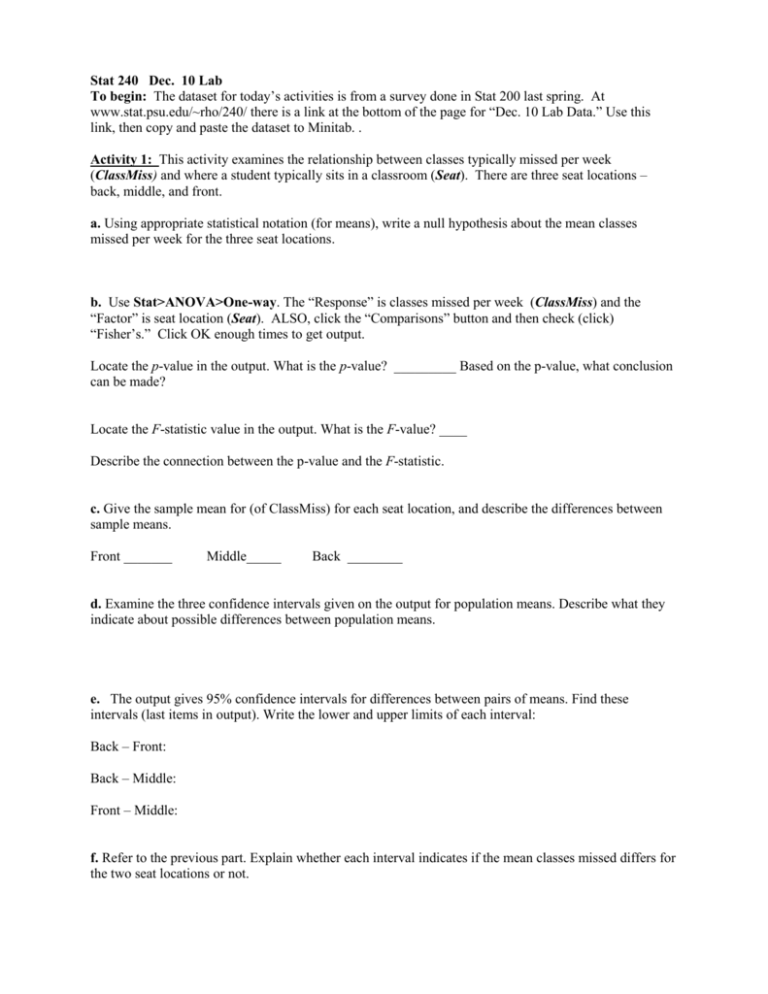
Stat 240 Dec. 10 Lab
To begin: The dataset for today’s activities is from a survey done in Stat 200 last spring. At
www.stat.psu.edu/~rho/240/ there is a link at the bottom of the page for “Dec. 10 Lab Data.” Use this
link, then copy and paste the dataset to Minitab. .
Activity 1: This activity examines the relationship between classes typically missed per week
(ClassMiss) and where a student typically sits in a classroom (Seat). There are three seat locations –
back, middle, and front.
a. Using appropriate statistical notation (for means), write a null hypothesis about the mean classes
missed per week for the three seat locations.
b. Use Stat>ANOVA>One-way. The “Response” is classes missed per week (ClassMiss) and the
“Factor” is seat location (Seat). ALSO, click the “Comparisons” button and then check (click)
“Fisher’s.” Click OK enough times to get output.
Locate the p-value in the output. What is the p-value? _________ Based on the p-value, what conclusion
can be made?
Locate the F-statistic value in the output. What is the F-value? ____
Describe the connection between the p-value and the F-statistic.
c. Give the sample mean for (of ClassMiss) for each seat location, and describe the differences between
sample means.
Front _______
Middle_____
Back ________
d. Examine the three confidence intervals given on the output for population means. Describe what they
indicate about possible differences between population means.
e. The output gives 95% confidence intervals for differences between pairs of means. Find these
intervals (last items in output). Write the lower and upper limits of each interval:
Back – Front:
Back – Middle:
Front – Middle:
f. Refer to the previous part. Explain whether each interval indicates if the mean classes missed differs for
the two seat locations or not.
Activity 2: Analyze the relationship between Sex (male, female) and LongFing. The variable LongFing
is the response to “On your right hand, which finger is longer – ring finger, index finger or are they the
same?”
a. The correct analysis in this situation is a chi-square test. Explain why this is so, and why an analysis of
variance F-test is not appropriate.
b. Write null and alternative hypotheses about the relationship between Sex and LongFing.
Null:
Alternative:
c. Use Stat>Tables>Cross tabulation. The classification variables are Gender and LongFing. Click on
“Chi-square analysis.”
What value is given for the Chi-square statistic? _____ What is the p-value?
What is the conclusion about the relationship between the two variables?
________
d. Return to the dialog box for the CrossTabulation (used in the previous part). Click “Row percents
(assuming you listed Sex first in the Classification variables; if you listed Sex second select Column
percents). For each sex, give percents in the three response categories for the LongFing question.
Female
Index
Ring
Same
Total
100%
Male
100%
Describe how males and females tend to differ with regard to the LongFing question.
g. What population do you think is represented by the sample in this activity? Considering the variables
involved, would your answer change if asked the same question about Activity 1 (about classes missed
and seat location)?
Activity 3:
This activity will be about IdealHt (in C10), which is the response (inches) to “How tall would you like
to be?”
A. Uses Graph>Histogram. Create a histogram of IdealHt. Describe the shape of the histogram. Why
isn’t it bell-shaped? (hint – about 2/3 of the class was female)
B. Use Stat>Basic Stats>Display Descriptive Statistics. Enter IdealHt as the variable, THEN click “By
variable” and enter Sex in the box by this item. The goal is to get separate statistics for each sex.
For each sex, list the five numbers of the 5-number summary of IdealHt.
C. Write a sentence that interprets Q3 (upper quartile) for the females.
D. Write a sentence that interprets the median for males.
E. Based on the 5-number summaries, explain whether we can the data (for each sex separately) are
symmetric.






